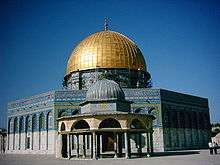Dome of the Rock
The Dome of the Rock (Arabic: قبة الصخرة Qubbat al-Sakhrah, Hebrew: כיפת הסלע Kippat ha-Sela) is an Islamic shrine located on the Temple Mount in the Old City of Jerusalem. It was initially completed in 691–92 CE at the order of Umayyad Caliph Abd al-Malik during the Second Fitna on the site of the Second Jewish Temple, destroyed during the Roman Siege of Jerusalem in 70 CE. The original dome collapsed in 1015 and was rebuilt in 1022–23. The Dome of the Rock is in its core one of the oldest extant works of Islamic architecture.[2]
| Dome of the Rock | |
|---|---|
Qubbat As-Sakhrah قبّة الصخرة | |
-Temple_Mount-Dome_of_the_Rock_(SE_exposure).jpg) | |
| Religion | |
| Affiliation | Islam |
| Location | |
| Location | Jerusalem |
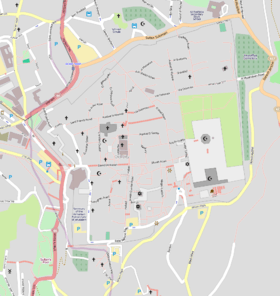 Location within the Old City of Jerusalem | |
| Administration | Ministry of Awqaf (Jordan) |
| Geographic coordinates | 31.7780°N 35.2354°E |
| Architecture | |
| Type | Shrine |
| Style | Umayyad, Abbasid, Ottoman |
| Date established | built 688–692,[1] expanded 820s, restored 1020s, 1545–1566, 1721/2, 1817, 1874/5, 1959–1962, 1993. |
| Specifications | |
| Dome(s) | 1 |
| Minaret(s) | 0 |
Its architecture and mosaics were patterned after nearby Byzantine churches and palaces,[3] although its outside appearance has been significantly changed in the Ottoman period and again in the modern period, notably with the addition of the gold-plated roof, in 1959–61 and again in 1993. The octagonal plan of the structure may have been influenced by the Byzantine Church of the Seat of Mary (also known as Kathisma in Greek and al-Qadismu in Arabic) built between 451 and 458 on the road between Jerusalem and Bethlehem.[3]
The Foundation Stone the temple was built over bears great significance in the Abrahamic religions as the place where God created the world and the first human, Adam.[4] It is also believed to be the site where Abraham attempted to sacrifice his son, and as the place where God's divine presence is manifested more than in any other place, towards which Jews turn during prayer. The site's great significance for Muslims derives from traditions connecting it to the creation of the world and the belief that Muhammad's Night Journey to heaven started from the rock at the center of the structure.[5][6]
A UNESCO World Heritage Site, it has been called "Jerusalem's most recognizable landmark,"[7] along with two nearby Old City structures, the Western Wall, and the "Resurrection Rotunda" in the Church of the Holy Sepulchre.[8] It is the earliest archaeologically-attested religious structure to be built by a Muslim ruler and the building's inscriptions contain the earliest epigraphic proclamations of Islam and of the Islamic prophet Muhammad.[9] The inscriptions proved to be a milestone, as afterward they became a common feature in Islamic structures and almost always mention Muhammad.[9] The Dome of the Rock remains a "unique monument of Islamic culture in almost all respects", including as a "work of art and as a cultural and pious document", according to historian Oleg Grabar.[10]
Description
Basic structure
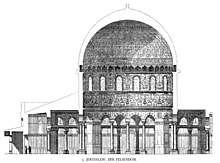
The structure is basically octagonal. It is capped at its centre by a dome, approximately 20 m (66 ft) in diameter, mounted on an elevated circular drum standing on 16 supports (4 tiers and 12 columns).[12]
Surrounding this circle is an octagonal arcade of 24 piers and columns.[13] The octagonal arcade and the inner circular drum create an inner ambulatorium that encircles the holy rock.
The outer walls are also octagonal. They each measure approximately 18 m (60 ft) wide and 11 m (36 ft) high.[12] The outer and inner octagon create a second, outer ambulatorium surrounding the inner one.
Both the circular drum and the exterior walls contain many windows.[12]
Interior decoration
The interior of the dome is lavishly decorated with mosaic, faience and marble, much of which was added several centuries after its completion. It also contains Qur'anic inscriptions. They vary from today's standard text (mainly changes from the first to the third person) and are mixed with pious inscriptions not in the Quran.[14]
The dedicatory inscription in Kufic script placed around the dome contains the date believed to be the year the Dome was first completed, AH 72 (691/2 CE), while the name of the corresponding caliph and builder of the Dome, al-Malik, was deleted and replaced by the name of Abbasid caliph Al-Ma'mun (r. 813–833) during whose reign renovations took place.
Exterior decoration
The decoration of the outer walls went through two major phases: the initial Umayyad scheme comprised marble and mosaics, much like the interior walls.[15] 16th-century Ottoman sultan Suleyman the Magnificent replaced it with Turkish faience tiles.[15] The Ottoman tile decoration was replaced in the 1960s with faithful copies produced in Italy.[15]
Surah Ya Sin (the 'Heart of the Quran') is inscribed across the top of the tile work and was commissioned in the 16th century by Suleiman the Magnificent.[16] Al-Isra, the Surah 17 which tells the story of the Isra or Night Journey, is inscribed above this.
History
Pre-Islamic background
The Dome of the Rock is situated in the center of the Temple Mount, the site of the Temple of Solomon and the Jewish Second Temple, which had been greatly expanded under Herod the Great in the 1st century BCE. Herod's Temple was destroyed in 70 CE by the Romans, and after the Bar Kokhba revolt in 135, a Roman temple to Jupiter Capitolinus was built at the site by Emperor Hadrian.[17]
Jerusalem was ruled by the Christian Byzantine Empire throughout the 4th to 6th centuries. During this time, Christian pilgrimage to Jerusalem began to develop.[18] The Church of the Holy Sepulchre was built under Constantine in the 320s, but the Temple Mount was left undeveloped after a failed project of restoration of the Jewish Temple under Julian the Apostate.[19]
Original Umayyad construction
The initial octagonal structure of the Dome of the Rock and its round wooden dome had basically the same shape as is does today.[12] It was built by the order of the Umayyad caliph Abd al-Malik (r. 685–705).[20] According to Sibt ibn al-Jawzi (1185–1256), construction started in 685/86, while al-Suyuti (1445–1505) holds that its commencement year was 688.[21] A dedicatory inscription in Kufic script is preserved inside the dome. The date is recorded as AH 72 (691/2 CE), the year most historians believe the construction of the original Dome was completed.[22] In this inscription, the name of "al-Malik" was deleted and replaced by the name of the Abbasid caliph al-Ma'mun (r. 813–833). This alteration of the original inscription was first noted by Melchior de Vogüé in 1864.[23] Construction cost was reportedly seven times the yearly tax income of Egypt.[24] An alternative interpretation of the inscription claims that it indicates the year when construction started.[25]
Some scholars have suggested that the dome was added to an existing building, built either by Muawiyah I (r. 661–680),[26] or indeed a Byzantine building dating to before the Muslim conquest, built under Heraclius (r. 610–641).[27]
Its architecture and mosaics were patterned after nearby Byzantine churches and palaces.[3] The two engineers in charge of the project were Raja ibn Haywah, a Muslim theologian from Beisan and Yazid ibn Salam, a non-Arab Muslim native of Jerusalem.[3][28]
Shelomo Dov Goitein of the Hebrew University has argued that the Dome of the Rock was intended to compete with the many fine buildings of worship of other religions: "The very form of a rotunda, given to the Qubbat as-Sakhra, although it was foreign to Islam, was destined to rival the many Christian domes."[29] K.A.C. Creswell in his book The Origin of the Plan of the Dome of the Rock notes that those who built the shrine used the measurements of the Church of the Holy Sepulchre. The diameter of the dome of the shrine is 20.20 m (66.3 ft) and its height 20.48 m (67.2 ft), while the diameter of the dome of the Church of the Holy Sepulchre is 20.90 m (68.6 ft) and its height 21.05 m (69.1 ft).
Narratives by the medieval sources about Abd al-Malik's motivations in building the Dome of the Rock vary.[10] At the time of its construction, the caliph was engaged in war with Christian Byzantium and its Syrian Christian allies on the one hand and with the rival caliph Ibn al-Zubayr, who controlled Mecca, the annual destination of Muslim pilgrimage, on the other hand.[10][30] Thus, one series of explanations was that Abd al-Malik intended for the Dome of the Rock to be a religious monument of victory over the Christians that would distinguish Islam's uniqueness within the common Abrahamic religious setting of Jerusalem, home of the two older Abrahamic faiths, Judaism and Christianity.[10][31] The other main explanation holds that Abd al-Malik, in the heat of the war with Ibn al-Zubayr, sought to build the structure to divert the focus of the Muslims in his realm from the Ka'aba in Mecca, where Ibn al-Zubayr would publicly condemn the Umayyads during the annual pilgrimage to the sanctuary.[10][30][31] Though most modern historians dismiss the latter account as a product of anti-Umayyad propaganda in the traditional Muslim sources and doubt that Abd al-Malik would attempt to alter the sacred Muslim requirement of fulfilling the pilgrimage to the Ka'aba, other historians concede that this cannot be conclusively dismissed.[10][30][31]
Abbasids and Fatimids
The building was severely damaged by earthquakes in 808 and again in 846.[32] The dome collapsed in an earthquake in 1015 and was rebuilt in 1022–23. The mosaics on the drum were repaired in 1027–28.[33]
Crusaders
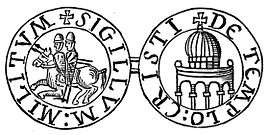
For centuries Christian pilgrims were able to come and experience the Temple Mount, but escalating violence against pilgrims to Jerusalem (Al-Hakim bi-Amr Allah, who ordered the destruction of the Holy Sepulchre, was an example) resulted in the Crusades.[34] The Crusaders captured Jerusalem in 1099 and the Dome of the Rock was given to the Augustinians, who turned it into a church, while the nearby Al-Aqsa Mosque first became a royal palace for a while, and then for much of the 12th century the headquarters of the Knights Templar. The Templars, active from c. 1119, identified the Dome of the Rock as the site of the Temple of Solomon. The Templum Domini, as they called the Dome of the Rock, featured on the official seals of the Order's Grand Masters (such as Everard des Barres and Renaud de Vichiers), and soon became the architectural model for round Templar churches across Europe.[35]
Ayyubids and Mamluks
Jerusalem was recaptured by Saladin on 2 October 1187, and the Dome of the Rock was reconsecrated as a Muslim shrine. The cross on top of the dome was replaced by a crescent, and a wooden screen was placed around the rock below. Saladin's nephew al-Malik al-Mu'azzam Isa carried out other restorations within the building, and added the porch to the Al-Aqsa Mosque.
The Dome of the Rock was the focus of extensive royal patronage by the sultans during the Mamluk period, which lasted from 1250 until 1510.
Ottoman period (1517–1917)
During the reign of Suleiman the Magnificent (1520–1566), the exterior of the Dome of the Rock was covered with tiles. This work took seven years. Some of the interior decoration was added in the Ottoman period.
Adjacent to the Dome of the Rock, the Ottomans built the free-standing Dome of the Prophet in 1620.
Large-scale renovation was undertaken during the reign of Mahmud II in 1817. In a major restoration project undertaken in 1874–75 during the reign of the Ottoman Sultan Abdülaziz, all the tiles on the west and southwest walls of the octagonal part of the building were removed and replaced by copies that had been made in Turkey.[36][37]
 The first-ever photograph of the building, 1842–44
The first-ever photograph of the building, 1842–44 View from the north, Francis Bedford (1862)
View from the north, Francis Bedford (1862) West front in 1862. By this date many of the 16th century tiles were missing.
West front in 1862. By this date many of the 16th century tiles were missing. Interior showing mosaic decoration (1914)
Interior showing mosaic decoration (1914) Tiled façade (2013)
Tiled façade (2013) Interior showing rock (1915)
Interior showing rock (1915)
British Mandate
Haj Amin al-Husseini, appointed Grand Mufti by the British in 1917, along with Yaqub al-Ghusayn, implemented the restoration of the Dome of the Rock and the Al-Aqsa Mosque in Jerusalem.
Parts of the Dome of the Rock collapsed during the 11 July 1927 earthquake, and the walls were left badly cracked,[38] damaging many of the repairs that had taken place over previous years.
Jordanian rule
In 1955, an extensive program of renovation was begun by the government of Jordan, with funds supplied by Arab governments and Turkey. The work included replacement of large numbers of tiles dating back to the reign of Suleiman the Magnificent, which had become dislodged by heavy rain. In 1965, as part of this restoration, the dome was covered with a durable aluminium bronze alloy made in Italy that replaced the lead exterior. Before 1959, the dome was covered in blackened lead. In the course of substantial restoration carried out from 1959 to 1962, the lead was replaced by aluminum-bronze plates covered with gold leaf.
Israeli rule
A few hours after the Israeli flag was hoisted over the Dome of the Rock in 1967 during the Six-Day War, Israelis lowered it on the orders of Moshe Dayan and invested the Muslim waqf (religious trust) with the authority to manage the Temple Mount / Haram al-Sharif, in order to "keep the peace".[39]
In 1993, the golden dome covering was refurbished following a donation of US$8.2 million by King Hussein of Jordan who sold one of his houses in London to fund the 80 kilograms of gold required.
Depictions in modern time
The Dome of the Rock has been depicted on the Obverse and reverse of several Middle East currencies:
 Reverse of a 1,000 Iranian rial banknote (1992).
Reverse of a 1,000 Iranian rial banknote (1992). Reverse of a 1 Jordanian dinar banknote (1959). Since 1992, the 20 Dinar note bears the Dome's depiction.
Reverse of a 1 Jordanian dinar banknote (1959). Since 1992, the 20 Dinar note bears the Dome's depiction.-donatedth_f.jpg) Obverse of a 50 Saudi riyal banknote (1983).
Obverse of a 50 Saudi riyal banknote (1983). Obverse of a 1 Palestinian pound banknote (1939).
Obverse of a 1 Palestinian pound banknote (1939).
Accessibility

The Dome is maintained by the Ministry of Awqaf in Amman, Jordan.[40]
Until the mid-twentieth century, non-Muslims were not permitted in the area. Since 1967, non-Muslims have been permitted limited access; however non-Muslims are not permitted to pray on the Temple Mount, bring prayer books, or wear religious apparel. The Israeli police help enforce this.[41] Israel restricted access for a short time during 2012 of Palestinian residents of the West Bank to the Temple Mount. West Bank Palestinian men had to be over 35 to be eligible for a permit.[42] Palestinian residents of Jerusalem, who hold Israeli residency cards, and Palestinians with Israeli citizenship are permitted unrestricted access.
Some Orthodox rabbis encourage Jews to visit the site, while most forbid entry to the compound lest there be a violation of Jewish law. Even rabbis who encourage entrance to the Temple Mount prohibit entrance to the actual Dome of the Rock.[43]
Religious significance
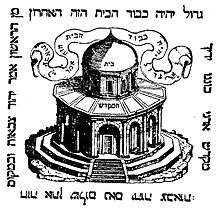
According to some Islamic scholars, the rock is the spot[44] from which the Islamic prophet Muhammad ascended to Heaven accompanied by the angel Gabriel. Further, Muhammad was taken here by Gabriel to pray with Abraham, Moses, and Jesus.[45] Other Islamic scholars believe that the Prophet ascended to Heaven from the Al-Aqsa Mosque.[46][47]
Muslims believe the location of the Dome of the Rock to be the site mentioned in Sura 17 of the Qur'an, which tells the story of the Isra and Mi'raj, the miraculous Night Journey of Prophet Muhammad from Mecca to "the farthest mosque", where he leads prayers and rises to heaven to receive instructions from Allah. The Night Journey is mentioned in the Qur'an in a very brief form and is further elaborated by the hadiths. Caliph Umar ibn Al-Khattab (579–644) was advised by Ka'ab al-Ahbar, a Jewish rabbi who converted to Islam,[48] that "the farthest mosque" is identical with the site of the former Jewish Temples in Jerusalem.
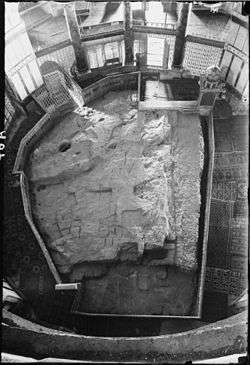
The Foundation Stone and its surroundings is the holiest site in Judaism. Though Muslims now pray towards the Kaaba at Mecca, they once faced the Temple Mount as the Jews do. Muhammad changed the direction of prayer for Muslims after a revelation from Allah. Jews traditionally regarded the location of the stone as the holiest spot on Earth, the site of the Holy of Holies during the Temple Period.
According to Jewish tradition, the stone is the site where Abraham prepared to sacrifice his son Isaac.
On the walls of the Dome of the Rock is an inscription in a mosaic frieze that includes an explicit rejection of the divinity of Christ, from Quran (19:33–35):
33. "So peace is upon me the day I was born, and the day I die, and the day I shall be raised alive!" 34. Such is Jesus, son of Mary. It is a statement of truth, about which they doubt. 35. It is not befitting to (the majesty of) Allah that He should take himself a child. Glory be to Him! when He determines a matter, He only says to it, "Be", and it is.
According to Goitein, the inscriptions decorating the interior clearly display a spirit of polemic against Christianity, whilst stressing at the same time the Qur'anic doctrine that Jesus was a true prophet. The formula la sharika lahu ("God has no companion") is repeated five times; the verses from Sura Maryam 19:35–37, which strongly reaffirm Jesus' prophethood to God, are quoted together with the prayer: Allahumma salli ala rasulika wa'abdika 'Isa bin Maryam – "O Lord, send your blessings to your Prophet and Servant Jesus son of Mary." He believes that this shows that rivalry with Christendom, together with the spirit of Muslim mission to the Christians, was at work at the time of construction.[29]
The Temple Institute wishes to relocate the Dome to another site and replace it with a Third Temple.[49] Many Israelis are ambivalent about the Movement's wishes. Some religious Jews, following rabbinic teaching, believe that the Temple should only be rebuilt in the messianic era, and that it would be presumptuous of people to force God's hand. However, some Evangelical Christians consider rebuilding of the Temple to be a prerequisite to Armageddon and the Second Coming.[50] Jeremy Gimpel, a US-born candidate for Habayit Hayehudi in the 2013 Israeli elections, caused a controversy when he was recorded telling a Fellowship Church evangelical group in Florida in 2011 to imagine the incredible experience that would follow were the Dome to be destroyed. All Christians would be immediately transported to Israel, he opined.[51]
Architectural homages
The Dome of the Rock has inspired the architecture of a number of buildings. These include the octagonal Church of St. Giacomo in Italy, the Mausoleum of Sultan Suleiman the Magnificent in Istanbul, the octagonal Moorish Revival style Rumbach Street Synagogue in Budapest, and the New Synagogue in Berlin, Germany. It was long believed by Christians that the Dome of the Rock echoed the architecture of the Temple in Jerusalem, as can be seen in Raphael's The Marriage of the Virgin and in Perugino's Marriage of the Virgin.[52]
Images
_02.jpg) The Interior of the Dome
The Interior of the Dome_1.jpg) The Dome itself
The Dome itself Ornaments and writing inside the Dome
Ornaments and writing inside the Dome More detailed image
More detailed image_3.jpg) Foundation stone of the Dome
Foundation stone of the Dome Panorama of the Temple Mount, including Al-Aqsa Mosque and Dome of the Rock, from the Mount of Olives
Panorama of the Temple Mount, including Al-Aqsa Mosque and Dome of the Rock, from the Mount of Olives



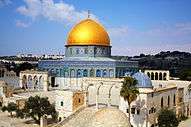
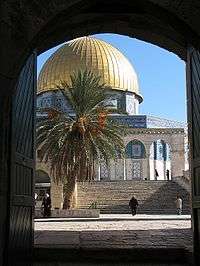
- Stereo card of the Dome of Rock (late 19th century)
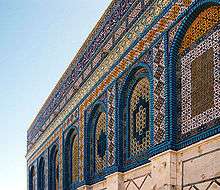 Exterior detail
Exterior detail Interior walls of the Dome of the Rock in Jerusalem, vessel with floral motif and crown
Interior walls of the Dome of the Rock in Jerusalem, vessel with floral motif and crown On a rainy day
On a rainy day
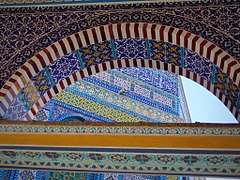
 Dome of the rock, Samuel Hirszenberg, 1908 (Tel Aviv Museum of Art)
Dome of the rock, Samuel Hirszenberg, 1908 (Tel Aviv Museum of Art)-Aerial-Temple_Mount-(south_exposure).jpg) Aerial view
Aerial view
See also
- Ablaq
- Abomination of desolation
- History of Medieval Arabic and Western European domes
- List of the oldest mosques in the world
- New Jerusalem
- Well of Souls
References
Citations
- Gil, Moshe (1997). A History of Palestine, 634–1099. Cambridge University Press. ISBN 978-0-521-59984-9. Archived from the original on 6 March 2017. Retrieved 30 August 2017.
- Slavik, Diane (2001). Cities through Time: Daily Life in Ancient and Modern Jerusalem. Geneva, Illinois: Runestone Press. p. 60. ISBN 978-0-8225-3218-7.
- Avner, Rina (2010). "The Dome of the Rock in light of the development of concentric martyria in Jerusalem" (PDF). Muqarnas. Volume 27: An Annual on the Visual Cultures of the Islamic World. Leiden: Brill. pp. 31–50 [43–44]. ISBN 978-900418511-1. JSTOR 25769691.
- Carol Delaney, Abraham on Trial: The Social Legacy of Biblical Myth, Princeton University Press 2000 p.120.
- M. Anwarul Islam and Zaid F. Al-hamad (2007). "The Dome of the Rock: Origin of its octagonal plan". Palestine Exploration Quarterly. 139 (2): 109–128.
- Nasser Rabbat (1989). "The meaning of the Umayyad Dome of the Rock". Muqarnas. 6: 12–21.
- Goldberg, Jeffrey (29 January 2001). "Arafat's Gift". The New Yorker. Archived from the original on 14 July 2015. Retrieved 11 July 2015.
- "UNESCO World Heritage". Archived from the original on 4 August 2017. Retrieved 26 December 2019.
- Johns 2003, p. 416.
- Grabar 1986, p. 299.
- "Drawings of Islamic Buildings: Dome of the Rock, Jerusalem". Victoria and Albert Museum. Archived from the original on 9 March 2009.
Until 1833 the Dome of the Rock had not been measured or drawn; according to Victor von Hagen, 'no architect had ever sketched its architecture, no antiquarian had traced its interior design...' On 13 November in that year, however, Frederick Catherwood dressed up as an Egyptian officer and accompanied by an Egyptian servant 'of great courage and assurance', entered the buildings of the mosque with his drawing materials... 'During six weeks, I continued to investigate every part of the mosque and its precincts.' Thus, Catherwood made the first complete survey of the Dome of the Rock, and paved the way for many other artists in subsequent years, such as William Harvey, Ernest Richmond and Carl Friedrich Heinrich Werner.
- "Dome of the Rock". Encyclopædia Britannica. Archived from the original on 15 June 2008. Retrieved 4 April 2012.
- The Dome of the Rock. Glass Steel and Stone. Archived 11 May 2013 at the Wayback Machine
- Robert Schick, Archaeology and the Quran, Encyclopaedia of the Qur'an
- "Qubba al-Sakhra". ArchNet. Archived from the original on 14 August 2019. Retrieved 8 April 2020.
- Palestine: Masjid al-Aqsa:The Dome of the Rock Archived 15 January 2019 at the Wayback Machine, at IslamicLandmarks.com, accessed 18 February 2019
- Chisholm, Hugh, ed. (1911). "Aelia Capitolina". Encyclopædia Britannica (11th ed.). Cambridge University Press. p. 256. Lester L. Grabbe (2010). An Introduction to Second Temple Judaism: History and Religion of the Jews in the Time of Nehemiah, the Maccabees, Hillel, and Jesus. A&C Black. p. 29.
- Davidson, Linda Kay and David Martin Gitlitz Pilgrimage: From the Ganges to Graceland : an Encyclopedia Volume 1, ABC-CLIO, Inc, Santa Barbara, CA 2002, p. 274.
- "Julian thought to rebuild at an extravagant expense the proud Temple once at Jerusalem, and committed this task to Alypius of Antioch. Alypius set vigorously to work, and was seconded by the governor of the province, when fearful balls of fire, breaking out near the foundations, continued their attacks, till the workmen, after repeated scorchings, could approach no more: and he gave up the attempt." Ammianus Marcellinus, Res Gestae, 23.1.2–3.
- Elad 1999, p. 45.
- Elad 1999, p. 44–45, notes 98–99.
- Necipoğlu 2008, p. 22.
- Vogüé 1864, p. 85.
- Jacob Lassner: Muslims on the sanctity of Jerusalem: preliminary thoughts on the search for a conceptual framework. In: Jerusalem Studies in Arabic and Islam. Band 31 (2006), p. 176.
- Sheila Blair, "What Is The Date Of The Dome Of The Rock?" in J. Raby & J. Johns (ed.), "Bayt Al-Maqdis: `Abd al-Malik's Jerusalem", 1992, Part 1, Oxford University Press: Oxford (UK), pp. 59-87. Via Did `Abd al-Malik Build Dome Of The Rock To Divert The Hajj From Makkah? Archived 18 February 2019 at the Wayback Machine at "Islamic Awareness", posted 18 February 2001, accessed 18 February 2019
- Oleg Grabar: The Meaning of the Dome of the Rock.
- Busse, Heribert (1991). "Zur Geschichte und Deutung der frühislamischen Ḥarambauten in Jerusalem". Zeitschrift des Deutschen Palästina-Vereins (in German). 107: 144–154. JSTOR 27931418.
- Richard Ettinghausen; Oleg Grabar; Marilyn Jenkins (2001). Islamic Art and Architecture 650–1250. Yale University Press. p. 20. ISBN 978-0-300-08869-4.
- Goitein, Shelomo Dov (1950). "The historical background of the erection of the Dome of the Rock". Journal of the American Oriental Society. 70 (2): 104–108. JSTOR 595539.
- Johns 2003, pp. 425–426.
- Hawting 2000, p. 60.
- Amiran, D.H.K.; Arieh, E.; Turcotte, T. (1994). "Earthquakes in Israel and adjacent areas: macroseismic observations since 100 B.C.E.". Israel Exploration Journal. 44 (3/4): 260–305 [267]. JSTOR 27926357.
- Necipoğlu 2008, p. 31.
- Stark, Rodney. God's Battalions; a Case for the Crusades. Harper Collins, NY, 2009, pp. 84–85.
- The Architecture of the Italian Renaissance, Jacob Burckhardt, Peter Murray, James C. Palmes, University of Chicago Press, 1986, p. 81
- Clermont-Ganneau 1899, p. 179.
- St. Laurent, Beatrice; Riedlmayer, András (1993). "Restorations of Jerusalem and the Dome of the Rock and their political significance, 1537–1928" (PDF). In Necipoğlu, Gülru (ed.). Muqarnas. Volume 10: Essays in Honor of Oleg Grabar. Leiden: Brill. pp. 76–84. JSTOR 1523174.
- Palestine Square (11 July 2016). "And the Land Lurched Forth: Remembering the 1927 Jericho Earthquake". Institute for Palestine Studies (IPS). Retrieved 8 April 2020.
- "Letter from Jerusalem: A Fight Over Sacred Turf by Sandra Scham". Archaeology.org. Archived from the original on 19 January 2012. Retrieved 4 April 2012.
- Business Optimization Consultants B.O.C. "Hashemite Restorations of the Islamic Holy Places in Jerusalem – kinghussein.gov.jo – Retrieved 21 January 2008". Kinghussein.gov.jo. Archived from the original on 23 February 2008. Retrieved 4 April 2012.
- Jerusalem's Holy Places and the Peace Process Archived 5 October 2006 at the Wayback Machine Marshall J. Breger and Thomas A. Idinopulos, Washington Institute for Near East Policy, 1998.
- Browning, Noah (15 August 2012). "Palestinians flock to Jerusalem as Israeli restrictions eased – Yahoo! News". News.yahoo.com. Archived from the original on 18 August 2012. Retrieved 31 October 2012.
- Zivotofsky. "Tzarich Iyun: The Har HaBayit – OU Torah". OU Torah. Archived from the original on 17 November 2015. Retrieved 16 November 2015.
- Braswell, G. Islam – Its Prophets, People, Politics and Power. Nashville, TN: Broadman and Holman Publishers. 1996. p. 14
- Ali, A. The Holy Qur'an – Translation and Commentary. Bronx, NY: Islamic Propagation Centre International. 1946. pp. 1625–31
- "Me'raj – The Night Ascension". Al-islam.org. Archived from the original on 14 November 2012. Retrieved 31 October 2012.
- "Meraj Article". Duas.org. Archived from the original on 25 October 2012. Retrieved 31 October 2012.
- Yakub of Syria (Ka'b al-Ahbar) Last Jewish Attempt at Islamic Leadership Committee for Historical Research in Islam and Judaism, © 2004–2012, accessed July 2013. Archived 13 May 2015 at the Wayback Machine "He continued to follow Rabbinic tradition such that later Islamic historians questioned whether he ever 'converted' to Islam."
- raisa (30 July 2014). "'Third Temple' crowdfunding plan aims to relocate Jerusalem's Dome of the Rock" (Text). The Stream - Al Jazeera English. Retrieved 25 November 2017.
- Stephen Spector, Evangelicals and Israel:The Story of American Christian Zionism, Oxford University Press, 2008 p. 202.
- Andrew Esensten U.S.-born Knesset candidate, Jeremy Gimpel, and his Dome of the Rock 'joke' Archived 20 January 2013 at the Wayback Machine, Haaretz 20 January 2013.
- Burckhardt, Jacob; Peter Murray; James C. Palmes (1986). The Architecture of the Italian Renaissance. University of Chicago Press. p. 81.
Works cited
- Creswell, K.A.C. (1924). The Origin of the Plan of the Dome of the Rock (2 Volumes). London: British School of Archaeology in Jerusalem. OCLC 5862604.
- Peterson, Andrew (1994). Dictionary of Islamic Architecture. London: Routledge. ISBN 0-415-06084-2
- Braswell, G. (1996). Islam – Its Prophets, People, Politics and Power. Nashville, TN: Broadman and Holman Publishers.
- Clermont-Ganneau, Charles (1899). "Chapter VIII The Kubbet es Sakhra". Archaeological Researches in Palestine During the Years 1873–1874. Volume 1. London: Committee of the Palestine Exploration Fund. pp. 179–227.CS1 maint: ref=harv (link)
- Elad, Amikam (1999). Medieval Jerusalem and Islamic Worship: Holy Places, Ceremonies, Pilgrimage (2nd ed.). Leiden: Brill. ISBN 90-04-10010-5.CS1 maint: ref=harv (link)
- Grabar, O. (1986). "Kubbat al-Ṣakhra". In Bosworth, C. E.; van Donzel, E.; Lewis, B. & Pellat, Ch. (eds.). The Encyclopaedia of Islam, New Edition, Volume V: Khe–Mahi. Leiden: E. J. Brill. pp. 298–299. ISBN 90-04-07819-3.
- Hawting, Gerald R. (2000). The First Dynasty of Islam: The Umayyad Caliphate AD 661–750 (Second ed.). London and New York: Routledge. ISBN 0-415-24072-7.
- Johns, Jeremy (January 2003). "Archaeology and the History of Islam: The First Seventy Years". Journal of the Economic and Social History of the Orient. 46 (4): 411–436. doi:10.1163/156852003772914848.CS1 maint: ref=harv (link)
- Necipoğlu, Gülru (2008). "The Dome of the Rock as palimpsest: 'Abd al-Malik's grand narrative and Sultan Süleyman's glosses". In Necipoğlu, Gülru; Bailey, Julia (eds.). Muqarnas: An Annual on the Visual Culture of the Islamic World. Volume 25. Leiden: Brill. pp. 17–105. ISBN 978-900417327-9. Retrieved 16 July 2020.CS1 maint: ref=harv (link)
- Ali, A. (1946). The Holy Qur’an – Translation and Commentary. Bronx, NY: Islamic Propagation Centre International.
- Islam, M. Anwarul; Al-Hamad, Zaid (2007). "The Dome of the Rock: origin of its octagonal plan". Palestine Exploration Quarterly. 139 (2): 109–128. doi:10.1179/003103207x194145.
- Christoph Luxenberg: Neudeutung der arabischen Inschrift im Felsendom zu Jerusalem. In: Karl-Heinz Ohlig / Gerd-R. Puin (Hg.): Die dunklen Anfänge. Neue Forschungen zur Entstehung und frühen Geschichte des Islam, Berlin (Verlag Hans Schiler) 2005, S. 124–147. English version: "A New Interpretation of the Arabic Inscription in Jerusalem's Dome of the Rock". In: Karl-Heinz Ohlig / Gerd-R. Puin (eds.): The Hidden Origins of Islam: New Research into Its Early History, Amherst, N.Y. (Prometheus Books) 2010
- Vogüé, Melchior de (1864). Le Temple de Jérusalem : monographie du Haram-ech-Chérif, suivie d'un essai sur la topographie de la Ville-sainte (in French). Paris: Noblet & Baudry.CS1 maint: ref=harv (link)
Further reading
- Grabar, Oleg (2006). The Dome of the Rock. Cambridge, Massachusetts: Belknap Press. ISBN 978-0-674-02313-0.
- Flood, Finbarr B. (2000). "The Ottoman windows in the Dome of the Rock and the Aqsa Mosque" (PDF). In Auld, Sylvia; Hillenbrand, Robert (eds.). Ottoman Jerusalem: The Living City: 1517–1917. Volume 1. London: Altajir World of Islam Trust. pp. 431–463. ISBN 978-1-901435-03-0.
- Kessler, Christel (1964). "Above the ceiling of the outer ambulatory in the Dome of the Rock in Jerusalem". Journal of the Royal Asiatic Society of Great Britain and Ireland (3/4): 83–94. JSTOR 25202759.
- Kessler, Christel (1970). "'Abd Al-Malik's inscription in the Dome of the Rock: a reconsideration". Journal of the Royal Asiatic Society of Great Britain and Ireland (1): 2–14. JSTOR 25203167.
- Richmond, Ernest Tatham (1924). The Dome of the Rock in Jerusalem: A Description of its Structure and Decoration. Oxford: Clarendon Press.
- St. Laurent, Beatrice (1998). "The Dome of the Rock and the politics of restoration". Bridgewater Review. 17 (2): 14–20.
External links
| Wikimedia Commons has media related to Dome of the Rock. |
- "Qubba al-Sakhra, Jerusalem". Archnet Digital Archive.
- Dome of the Rock Sacred sites
- The Dome of the Rock in Jerusalem Masterpieces of Islamic Architecture
- Ochs, Christoph (2010). "Dome of the Rock". Bibledex in Israel. Brady Haran for the University of Nottingham.
- Allen, Terry (2014). "The Marble Revetment of the Piers of the Dome of the Rock". Occidental, CA: Solipsist Press. Retrieved 26 March 2017.
